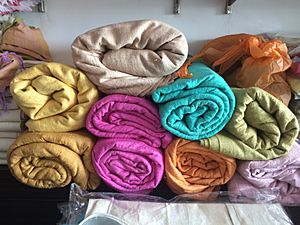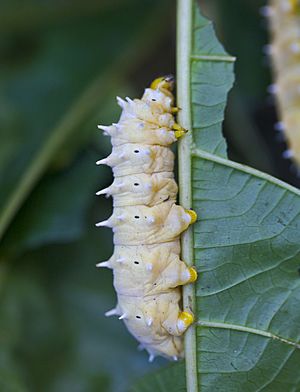Ailanthus silkmoth facts for kids
Quick facts for kids Ailanthus silkmoth |
|
|---|---|
 |
|
| Adult male | |
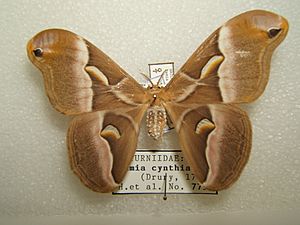 |
|
| Adult female | |
| Scientific classification | |
| Synonyms | |
|
The Ailanthus silkmoth (its scientific name is Samia cynthia) is a type of large moth. People use it to make silk fabric. However, it is not as commonly raised as the regular silkworm, Bombyx mori.
This moth has very big wings, usually about 11 to 12.5 centimeters (4.4 to 4.9 inches) wide. Each wing has a special quarter-moon shaped spot. They also have white and yellow stripes on a brown background. You can see eyespots on the front part of their upper wings. A scientist named Dru Drury first described this moth in 1773.
Contents
What is Eri Silk?
The Ailanthus silkmoth gets its name from the Ailanthus tree. This tree is what the caterpillars usually eat. There is a special kind of Ailanthus silkmoth in India and Thailand. It is called S. cynthia ricini.
This type of moth eats the leaves of the castor bean plant. It is famous for making a special kind of silk called eri silk. This is why it is often called the eri silkmoth.
The eri silkworm is one of the few silkworms that people have fully tamed. It is like the Bombyx mori silkworm in this way. Eri silk is very strong and lasts a long time. However, it is hard to unroll the silk thread from its cocoon. Because of this, eri silk is often spun like cotton or wool instead.
Where Do Ailanthus Silkmoths Live?
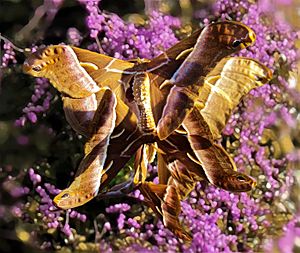
Ailanthus silkmoths are found in many parts of the world. Scientists have studied where these moths live.
Native Homes
These moths originally come from Asia. You can find them in countries like China and Korea.
New Homes Around the World
Over time, these moths have spread to many new places. Some moths escaped from farms where they were being raised. Others were brought to new areas on purpose. Now, you can find them in:
- Asia: Japan, India, Thailand
- Australia: Australia
- The Americas: Canada, United States, Venezuela, Uruguay, Brazil
- Africa: Tunisia
- Europe: France, Austria, Switzerland, Germany, Spain, Bulgaria, Italy
The Life Cycle of the Ailanthus Silkmoth
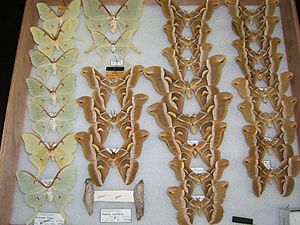
Like all moths, the Ailanthus silkmoth goes through several stages. It starts as an egg and changes into a larva, then a pupa, and finally an adult moth.
Eggs
The female moth lays whitish eggs with brown marks. She lays them in rows of 10 to 20 on leaves. The eggs usually hatch in about 7 to 10 days.
Larvae (Caterpillars)
When they first hatch, the larvae (caterpillars) are yellow. They like to stay together in groups. As they grow bigger, they become more solitary. They turn a whitish-green color and have white bumps along their backs. They also have small black dots. These caterpillars go through five growth stages. They can grow to be about 7 to 7.5 centimeters (2.8 to 3 inches) long.
Pupae (Cocoons)
After growing, the caterpillar spins a cocoon. This cocoon is made of silk and is usually off-white or grey. It is spun on the leaves of the plant the caterpillar was eating. The cocoon has a clear opening that the adult moth will use to get out.
Adult Moths
Adult moths do not have mouth parts. This means they cannot eat or drink anything. Female moths are ready to mate in the evening or night. This happens after they come out of their cocoons in the late morning. In northern Europe, adult moths fly during May and June. They usually have one generation per year there. In southern Europe, a second group of moths might appear in September.
What Do Ailanthus Silkmoths Eat?
The caterpillars of the Ailanthus silkmoth can eat leaves from different trees and shrubs. However, the female moths prefer to lay their eggs on the "tree of heaven" (Ailanthus altissima). The caterpillars also grow best when they eat this tree. The "tree of heaven" is often planted in cities as a decorative tree.
Remember, the special type of Ailanthus silkmoth called S. cynthia ricini eats the leaves of the castor bean plant.
See also
 In Spanish: Mariposa de seda del Ailanto para niños
In Spanish: Mariposa de seda del Ailanto para niños



